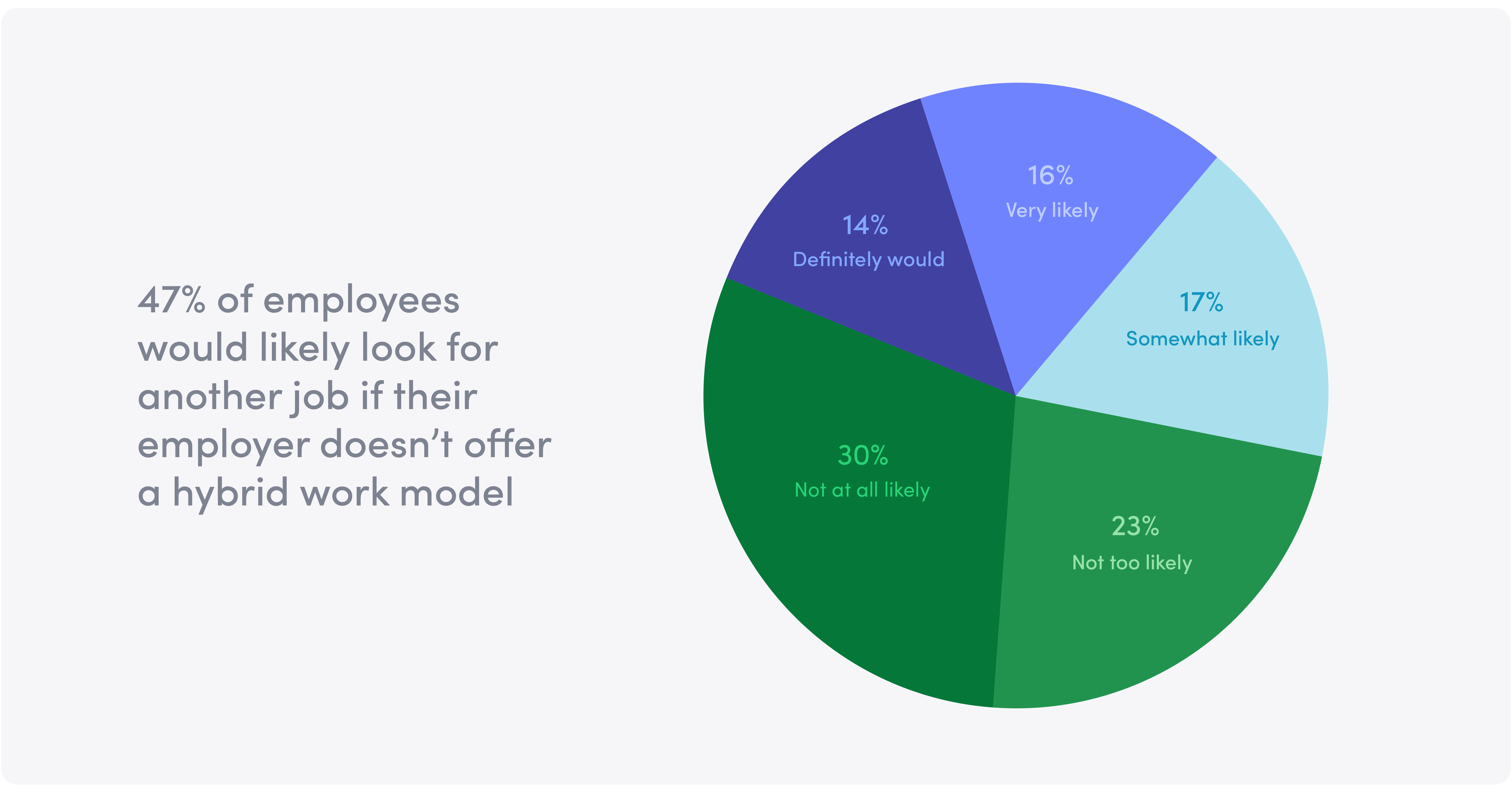Remote, hybrid or back to the office? How to decide on the right return-to-work plan for your company
After a long period of social distancing and having no choice but to adapt to a 100% remote work setup, things are returning to some semblance of normal for employees. With several highly effective vaccines for COVID-19 now available to the general adult population, businesses everywhere are getting the green light to open up and bring people back into the workplace.

Time to celebrate, right? Well, it depends.
Some companies such as Microsoft, IBM, Slack, Ford, Target, and Citigroup have already planned out and gone full steam ahead on their own version of a hybrid work model that includes both remote and in-office work, but that return-to-work plan is not going to work for every company.
Your return-to-work plan: What’s best?
To even begin to decide on what will work best for your team, you’ll need to ask yourself:
- Has the remote setup been working well for my company?
- Do my employees even want to go back to the office?
- If some do, how do we decide when, how and who goes back?
- And if opinions are split, how do we balance each side and make sure all employees’ preferences are heard and accounted for?
Those are the types of questions we’ll help you sort through.
Here are 6 tips to help you decide whether you should return to the office (if at all), so you can put together the best return-to-work plan for your company:
1. Listen to employee feedback
As challenging as this past year has been for businesses, it has arguably been far more challenging for individual employees since they’ve had to continue being productive despite what’s going on in their new working environment (their home), or how much child and family care coverage they have, and to what level their home office is equipped for remote work. Employees also have no choice but to look to their company leaders for guidance on what to do and how to move forward.
For that reason, you should take your employee feedback into consideration when deciding whether to go fully remote, go back to the office, or start a hybrid work model in your return-to-work strategy.
You can unlock your employee feedback in a few different ways:
- Sending an employee survey
- Having an open forum at an all-hands meeting
- Incorporating feedback exchange during individual 1v1 discussions
A perfect example of a company who has relied on employee feedback for their approach to returning to the office is IBM.
Earlier in 2021, IBM held a “global brainstorm” with the entire company to get real-time feedback about whether employees want to return to work, and how often. In that session that they call a “Jam” – 60% of employees said they wanted to go into the office one to three days a week and 72% said they saw the office as having a vital role for employees to come together and collaborate on projects in the future.
That exact employee feedback helped shape how IBM is approaching its future hybrid work model, which they admit isn’t set in stone and will need to adapt as the global pandemic situation develops differently around the world where their employees are.
An example of what not to do in a return-to-work plan comes from none other than Google.
Before vaccines were even available to most of their employees (CEO Sundar Pichai voiced intentions in early April 2021 about bringing employees back to the office; in L.A., vaccines were only made available to individuals 16 and older in mid-April), Google leadership decisively shared their commitment to return to the office, even while many of their employees don’t want to go back.
Google subsequently publicly backtracked their initial return to work plans in favor of a much more remote-friendly stance after finally listening to their employees’ feedback.
2. Refer to the data
Like with any major business decision, data is your friend. It helps give you an objective perspective of how others are approaching the same decision you’re about to make. Pair that current, relevant data with the employee feedback you’ve been gathering from inside your organization, and you’ll be in a much better position to design a path forward that works for you.
Some key questions to gather data around:
- Which working setup do employees typically prefer: remote, in office, or hybrid?
- How many days a week in the office vs. remote is most desirable?
- How are other company leaders thinking about returning to work?
In a PwC study, more than half (55%) of 1,200 workers surveyed said they prefer working remotely three days a week. Meanwhile, 68% of 133 U.S. executives said workers should be in the office at least three days a week, citing concerns that company culture will not survive a purely remote work model. Likewise, in an Envoy return to the workplace survey, nearly half of respondents (48%) say they’d like to work some days remotely and some days from the office.
Using data can also steer you towards something you hadn’t even thought about, such as the idea of negotiating a compromise with employees who feel strongly one way or another.
In that same Envoy study, 41% of workers said they would be willing to take a job with a lower salary if their company offered a hybrid work model. And a WeWork study revealed that 75% of employees are willing to give up at least one benefit or perk for the freedom to choose their work environment, while 64% would pay up to $300 for access to an office space.
If the operational costs of managing a hybrid work model is something that is holding you back from making a decision on a return-to-work plan, referring to data about different angles of this back-to-the-office challenge can offer alternative solutions to make everyone happy.
3. Assess the impact on your tools & processes
Whatever decision you make regarding going remote, back to the office, or hybrid, remember that your decision doesn’t just impact where your employees work but how they work – by themselves, with each other and with everyone else in their professional lives.
This means you’ll need to think about how your tools and processes would need to adapt to suit your future setup. These are some areas of your return-to-work plan where your tools and processes may change:
- Hiring. Your stance on remote, hybrid or in-office will impact your future recruiting efforts and who you’ll be able to attract. At the very least, your HR team will likely need to rework job descriptions and contracts, not only for new hires but for all your existing employees and contractors.
- Communication. Your employees have already done a lot of adapting to make employee communication work while remote, whether that means setting standard working hours, defining when to use Slack vs. email, or communicating more asynchronously. Whatever your future setup is, this is an area that you’ll need to continue to refine and create norms and standards around.
- Onboarding. Your onboarding process is designed to set your new team members up with everything they need to succeed, so you don’t want to drop the ball on that. Going forward, you’ll need to be clear on: how will employees be onboarded if they are working from home? How much in-person onboarding, if any, is required or expected? What does a remote employee onboarding process look like?
- Technology. Your company may have already provided a work-from-home stipend to employees to ensure they could continue to be productive while working from their homes. Will that be enough support in the long term? If not, what other technology needs will you need to address? Are there equity issues at play? What will these technologies cost?
- Performance evaluations. If employees and their managers rarely or never interact in person, what does that mean for your evaluation, promotion and compensation processes?
4. Consider your goals and vision as a company
How does a decision to go fully remote, hybrid, or back to the office align with your vision and goals as an organization?
This question is a crucial one to think through carefully, because you need to balance your company’s driving beliefs with the practical impact of those decisions on your business and HR processes.
A great example of a company who has managed this well is social media software company Buffer, who ditched their office way back in 2015 and have been a distributed company for years even before the pandemic. Their leadership’s perspective on remote work is well documented, and they were able to align on a remote work model as the right solution for their employees, for reasons including freedom, time zone coverage, productivity and lots more.
Does your team have to reach the same level of consensus as Buffer’s leadership team? Not necessarily. But you’ll always be better off using your company goals as a guide to your decision making than to neglect them.
Also, keep in mind that this step will be easier for some companies than others. Different people in your organization might view your company goals differently, which may prolong your ability to reach an agreement on a return-to-work plan. And if your business’ product or service requires regular, real-time face-to-face interaction with customers and clients, it might mean you can’t get rid of your office altogether even if you’re strongly considering it.
5. Be transparent
If you’re holding off any sort of employee communications about your decision until after that decision has been made, you’re communicating too late. What you’ll essentially be doing is fostering uncertainty among your employees and within your organizational culture, where rumors, gossip and assumptions will thrive.
What will typically follow closely after that is a wide sense of employee unrest and insecurity about your company’s (and their) future, and then a trend of team members starting to look for a job elsewhere where the remote vs. in-office stance is clear.

What happens if even you as a leader are uncertain about the future, and don’t have any information or decisions yet to share with employees? You can still create a communication plan in times of uncertainty, by sharing:
- What decisions you expect to make in the near future
- What your decision making process entails / who is involved
- When and how employees should expect to get updates on that decision
Covering these points of communication in periodic small meetings and one-and-ones will help you understand your individual team members’ most pressing issues. Also, ideally your organization has designated some forum or message board where employees can pose their questions, so that the communication on a return-to-work plan isn’t only flowing top-down.
6. Commit to a decision timeline
Deciding if (and then how) your employees are going back to the office isn’t something you should do lightly. And while, fortunately, nobody is forcing your company to make a decision by a certain date, it’s in your best interest to consider all of your options and pick a direction sooner than later.
Many employees already have their own expectations about what’s going to happen this year: according to a survey of 7,000 professionals on Blind, an anonymous professional network, 67% believe everyone will be back in the office by the end of next year. The other one-third of professionals believe they will be back in the office in the summer of 2021.
Rather than staying stuck in limbo, make your decision – or at least commit to when you will make your decision – to give employees peace of mind and certainty, and also give your HR and operations teams something to build upon.
A well-planned return-to-work plan can reap dividends for your organization in the form of increased employee engagement and mitigation of costly turnover. It’s worth putting some thought into it before rolling it out as a formal policy.
Linda Le Phan leads content for Compt, an employee stipends platform that’s fully customizable to your company’s needs, 100% IRS-compliant, and supports global teams.




